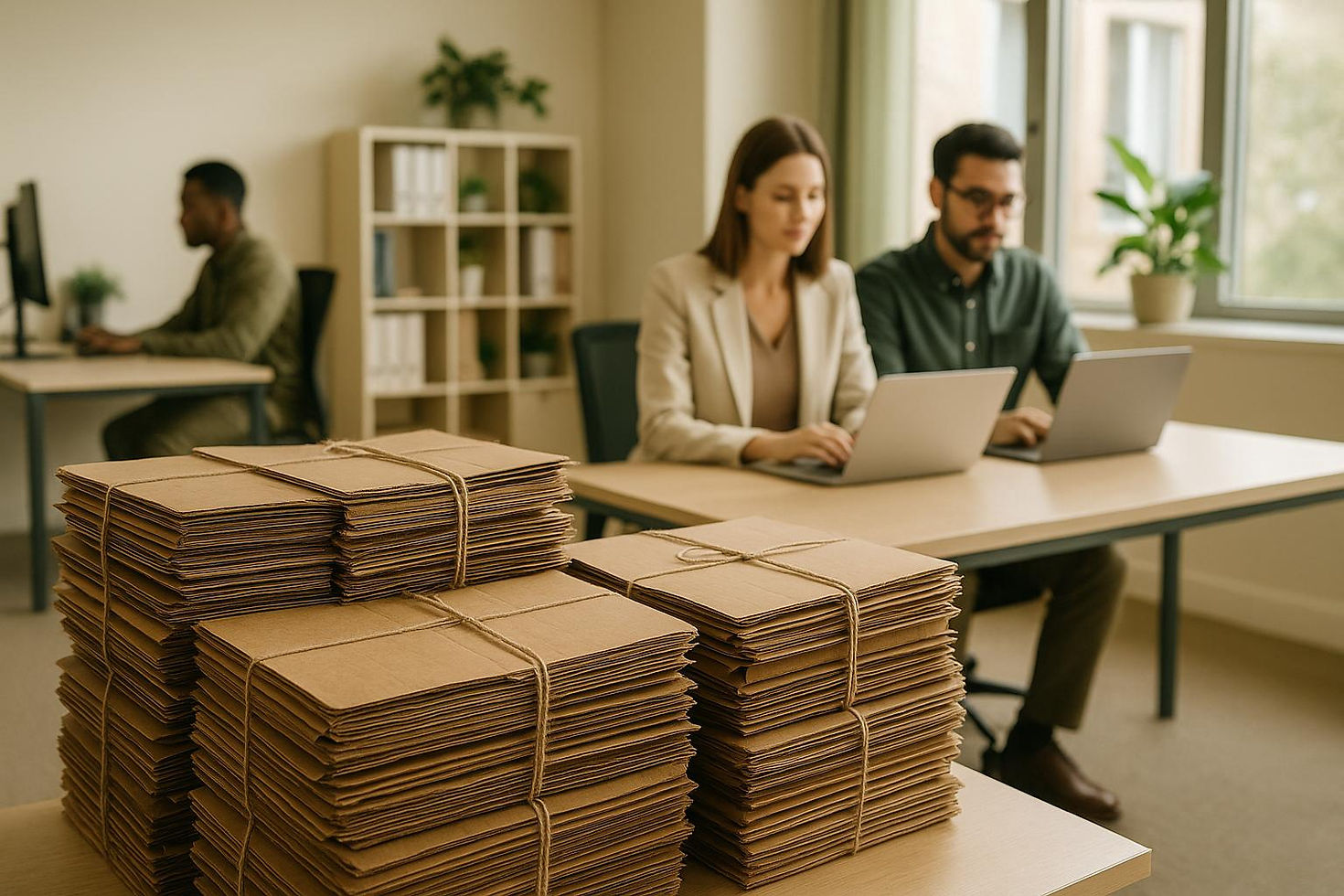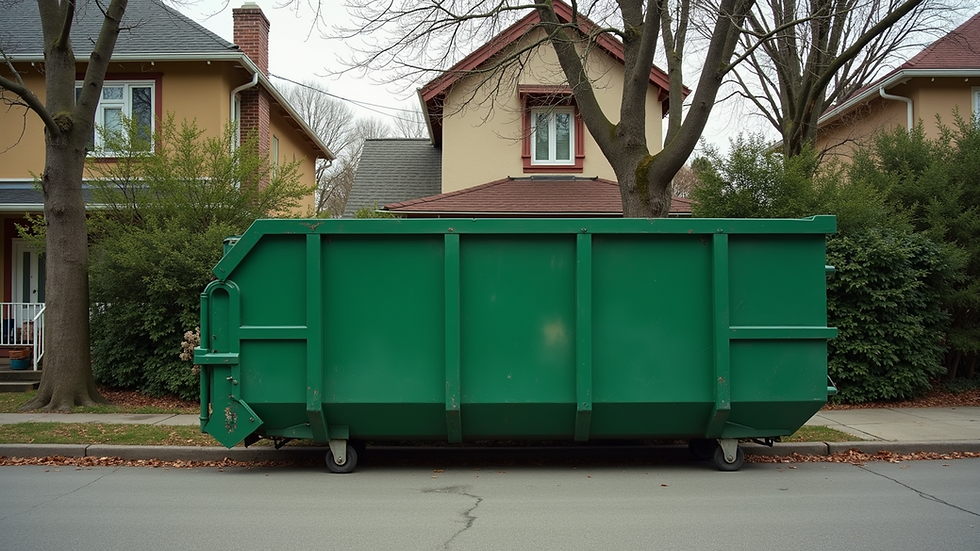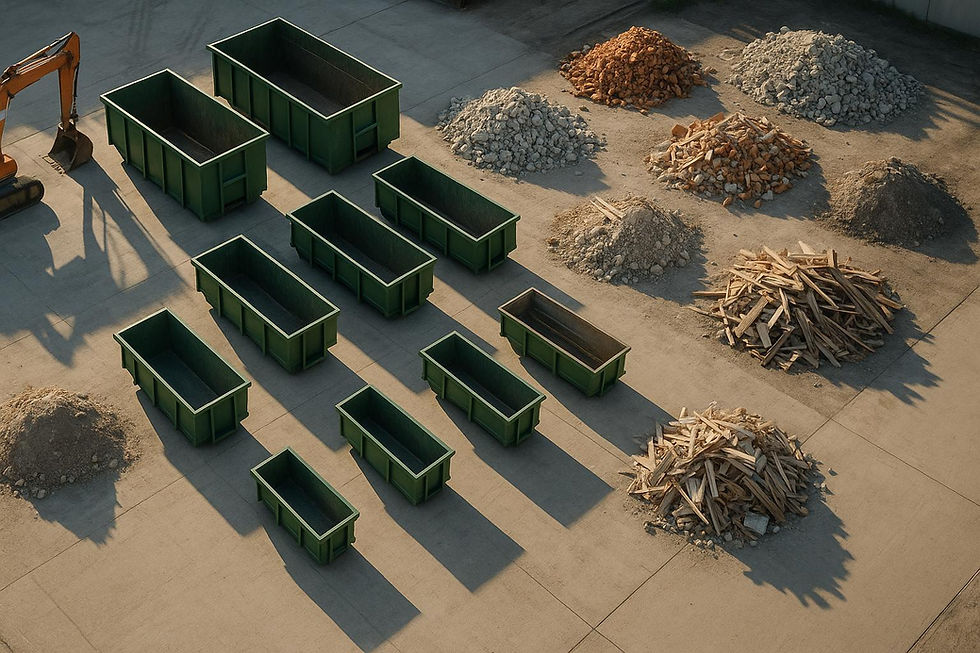
How Cardboard Recycling Boosts Business Revenue
- Gregory Cunningham
- May 22
- 9 min read
Updated: Sep 1
Recycling cardboard can save your business money, reduce waste, and even generate revenue. Here's how:
- Save Costs: Recycling lowers trash disposal fees and reduces landfill use.
- Earn Money: Clean, sorted, and baled cardboard can be sold to recyclers or paper mills.
- Energy Efficiency: Recycling uses 75% less energy than making new cardboard.
- Tax Benefits: Many states offer tax credits and exemptions for recycling equipment.
- Eco-Friendly Image: Attract eco-conscious customers by promoting your recycling efforts.
How We Turned Cardboard into Cash with Incredible Profit Margins! ♻️💰
Measuring and Cutting Cardboard Waste
Keeping tabs on your recycling efforts can do wonders for both your wallet and the environment. By systematically tracking and managing your cardboard waste, you can boost recycling revenue and cut down on disposal costs.
How to Track Cardboard Waste
Start with a waste audit to get a clear picture of how much cardboard your business generates daily and weekly. This initial data can reveal ways to save money and even create new revenue streams.
Here are some practical ways to measure cardboard waste:
- Keep an eye on how often your recycling containers are picked up and how full they are at collection.
- Use standard metrics to estimate weight - for example, cardboard typically weighs 106 pounds per cubic yard.
- Take note of any seasonal changes in your cardboard output.
- Separate and track different types of cardboard, like corrugated containers versus paperboard.
For a more structured approach, the EPA's ENERGY STAR Portfolio Manager® is a free online tool that can track waste metrics for 29 categories, including cardboard. It also provides detailed reports to help you stay on top of your recycling efforts.
Once you have a tracking system in place, the next step is to ensure your cardboard stays clean and ready for recycling. Clean materials are worth more and reduce disposal costs.
Keeping Cardboard Clean for Recycling
Clean, well-sorted cardboard is more valuable to recyclers, while contaminated materials can lead to higher disposal fees. Here’s how to keep your cardboard in top shape:
- Set Up Dedicated Collection PointsPlace clearly marked recycling stations in high-traffic areas, especially where cardboard is frequently used, like shipping and receiving departments. Add signs with images to make sorting simple and effective.
- Follow Proper Handling GuidelinesBefore recycling, make sure to remove items that can’t be processed with cardboard, such as:
- Packing materials like peanuts, bubble wrap, and air pillows
- Tape and labels
- Food residue or grease-stained sections
- Optimize Storage SpaceFlatten boxes to save room and cut down on transportation costs. Store your cardboard in a dry, covered area to prevent moisture damage.
For businesses dealing with large amounts of cardboard, investing in a baler or compactor can be a game-changer. This equipment reduces storage needs, lowers handling costs, and makes the material more appealing to recyclers.
Setting Up Your Recycling System
A well-organized recycling system can turn cardboard waste into a source of revenue while also trimming costs.
Picking the Best Dumpster Size
Choosing the right dumpster size is a critical decision that directly impacts your expenses. Too small, and you'll face overflow charges. Too large, and you're paying for space you don’t need.
To figure out the best size for your needs, start by tracking how much cardboard your business generates each week. For reference, the average office worker produces about 25 pounds of paper waste annually. Dump & Go's 15-to-20-yard dumpsters are a practical option, offering a balance between capacity and cost efficiency.
When deciding on a dumpster, take these factors into account:
- How much storage space is available on your property
- The volume of cardboard you produce weekly
- How often pickups are scheduled
- Seasonal changes in waste production
- Potential growth in your operations
Using mobile compaction can reduce the volume of cardboard by up to 70%, which means you might be able to opt for a smaller dumpster and save money.
Staff Training Guidelines
After setting up the right equipment, training your staff is the next step to ensure your recycling program runs smoothly and generates maximum revenue. For example, Microsoft's Redmond campus achieved an impressive 90% waste diversion rate thanks to thorough employee education.
"Employees who receive training are more likely to engage with your program and correctly recycle. In return, it will help your business reduce its environmental footprint, increase recycling rates and landfill diversion, and reduce associated waste costs." - RoadRunner WM
To get your team on board, create a training program that includes:
- How to properly prepare cardboard for recycling
- Tips for avoiding contamination
- Correct storage procedures
- Collection schedules and timing
- Awareness of recycling's environmental benefits
Incorporate visual aids and hands-on demonstrations to make the training more effective. Regular refresher sessions can help maintain enthusiasm and ensure everyone stays on track with proper recycling habits.
Planning Collection Times
Once your system and training are in place, focus on optimizing collection schedules. Here’s a real-world example: a private waste collection company cut costs by 63% and reduced pickups by 70% by adjusting their schedule based on actual bin fullness data.
To fine-tune your collection times:
- Monitor how quickly containers fill to identify patterns
- Schedule pickups before bins overflow
- Adjust frequency to account for seasonal changes
- Factor in weather conditions that might affect cardboard storage
- Coordinate with your team’s workflow to minimize disruptions
Smart monitoring systems can track container fullness in real time, allowing you to make data-driven decisions. These systems help avoid overflows while ensuring you don’t pay for unnecessary pickups.
Timing isn’t just about efficiency - it also protects your recyclable cardboard from weather damage, preserving its resale value. Work closely with your waste management provider to develop a schedule that keeps operations running smoothly while maintaining the quality of your materials.
Making Money from Recycled Cardboard
Using Balers to Increase Value
Investing in balers can double the price of your recycled cardboard compared to selling it loose. These machines compress cardboard, cutting down waste volume by as much as 90%, which makes storage and transport far more efficient. When choosing a baler, think about the size and speed that best fit your operations. As Mike Blais from Maren Engineering Corp points out:
"It's always important to shop around for the right baling equipment", Blais says. "Selecting a baler that's too small or too slow will lead to inefficiencies while a baler that's too large or fast can waste money, increase energy costs and require a longer return on investment (ROI)."
For example, a national retailer improved efficiency by switching to mill-spec bales. This change allowed them to cut staffing needs from 15 people across three shifts to just three while maintaining the same output. Once you’ve optimized your baling process, it’s time to explore the best buyer channels to maximize profits.
Finding Cardboard Buyers
After increasing the value of your cardboard through baling, the next step is finding the right buyers. Here’s a breakdown of potential buyers and what they typically require:
Buyer | Benefits | Requirements |
Recycling Facilities | Convenient local pickup | Clean, sorted materials |
Paper Mills | Higher prices for large volumes | Mill-spec bales (40,000 lb minimum) |
Used Box Recyclers | Quick turnaround | Specific box types (e.g., Gaylord) |
Local Businesses | Lower shipping costs | Consistent supply commitments |
Take Used Box Recycling (UBR) as an example. As of December 2022, they were paying up to $10 per used Gaylord box. They also offer local pickup and handle the removal process, making it easy for businesses to turn waste into income.
Marketing Your Green Practices
Promoting your recycling efforts can attract environmentally conscious customers and even boost your revenue. In fact, 72% of consumers prefer brands that prioritize sustainability, and 30% are willing to pay more for eco-friendly products.
IKEA is a great example of this. The company has pledged to use only renewable or recycled materials by 2030, and their transparent commitment to sustainability has strengthened customer loyalty and enhanced their brand image.
Here’s how you can effectively market your recycling program:
- Highlight specific waste reduction achievements with measurable data.
- Share your sustainability efforts on social media to engage your audience.
- Apply for certifications that showcase your eco-friendly practices.
- Create educational content about your environmental impact.
- Collaborate with influencers who focus on sustainability to amplify your message.
With 37% of U.S. consumers prioritizing sustainability in their buying decisions, showcasing your recycling initiatives can help you tap into this growing market while generating extra income from your eco-friendly practices.
Saving Money Through Recycling
Cutting Landfill Fees
Recycling cardboard isn’t just good for the environment - it’s a smart way for businesses to cut waste costs. Paper and cardboard make up about 56% of landfill waste in the U.S., so there’s a big opportunity to save on disposal fees. For example, recycling just one ton of cardboard can free up three cubic yards of landfill space, directly reducing tipping fees.
On top of that, recycling cardboard uses up to 75% less energy compared to producing new material. This means businesses not only save money but also improve their operational efficiency by consuming fewer resources.
To get the most out of cardboard recycling, businesses can take simple steps like separating cardboard from other waste, using balers to compress it, and scheduling regular pickups. Companies in New England, for instance, can take advantage of services like Dump & Go, which provides quick dumpster rentals and eco-friendly waste solutions, making the process even easier and more cost-effective.
Finding Tax Benefits
Recycling programs can also bring in tax perks for businesses. For instance, in Virginia, companies can claim a recycling equipment income tax credit equal to 10% of the equipment’s purchase price. Similarly, Arizona offers a 10% tax credit for equipment used to process postconsumer recyclables. North Carolina takes it further by offering sales tax exemptions for companies that either manufacture recycled products or operate large recycling facilities with at least 250 full-time employees.
Property tax incentives add another layer of savings. In Nevada, qualifying businesses can get a 75% personal property tax exemption for 10 years, while Iowa provides a 100% sales tax exemption on industrial machinery and equipment used in recycling operations.
To make the most of these tax breaks, businesses should keep detailed records of their recycling-related expenses and equipment purchases. It’s also a good idea to research local incentive programs by reaching out to state environmental agencies and consulting with tax professionals who specialize in environmental credits.
Conclusion
Recycling cardboard not only helps businesses save money but also supports environmentally responsible practices. The growing adoption of recycling programs highlights the dual benefits of reducing environmental impact and improving financial efficiency. Considering the significant amount of cardboard waste that ends up in landfills, recycling offers a practical way to cut costs while meeting environmental regulations.
Recycling cardboard can reduce energy consumption by up to 75% compared to producing new materials. Additionally, recycling just one ton of cardboard saves three cubic yards of landfill space, making it an environmentally friendly choice. These operational savings also pave the way for financial perks, such as tax incentives.
Tax benefits further enhance the appeal of recycling programs. As industry experts point out:
"Having a well-managed cardboard recycling program saves a company valuable resources, reduces waste costs and keeps you compliant with recycling legislation".
The combination of lower disposal costs, operational savings, and tax advantages makes recycling a smart business move.
For businesses in New England, Dump & Go offers efficient 15-to-20-yard dumpster rentals tailored for managing recyclable cardboard. Their eco-conscious waste solutions help companies cut disposal costs and turn cardboard waste into a source of revenue. By adopting these strategies, businesses can transform their waste management approach, benefiting both their financial health and the environment.
FAQs
How can my business track and manage cardboard waste to increase recycling revenue?
To get the most out of recycling cardboard, start by creating a dedicated collection area that's easy for employees to reach. Make sure this area is convenient and encourages regular use. Weigh the collected cardboard periodically with a scale to track how much you're recycling and get a sense of the potential earnings. Keeping a simple log - either on paper or digitally - can help you stay organized, spot trends, and find ways to improve your process.
Breaking down cardboard before placing it in recycling bins is crucial. This not only saves space but also reduces how often bins need to be emptied, cutting down on waste management costs. By keeping an eye on how much cardboard you're recycling and the frequency of pickups, you can adjust your strategy to make the process more efficient and cost-effective.
For businesses in New England, options like Dump & Go offer eco-friendly dumpster rentals with quick delivery. These services can simplify your recycling efforts, allowing you to focus on increasing revenue while managing waste responsibly.
How can I ensure my cardboard stays clean and valuable for recycling?
To ensure your cardboard stays in good condition for recycling, keep it in a dry, sheltered spot to avoid moisture, which can degrade its quality. Check that it’s free from food residue, grease, or other contaminants, as these can render it unusable for recycling. Flatten your boxes to save storage space and simplify handling, and take off any non-recyclable materials like tape or plastic labels before recycling. By keeping your cardboard clean, dry, and properly prepared, you not only make recycling easier but might also turn it into an opportunity to earn some extra income.
How can I find buyers for my recycled cardboard and get the best price?
To sell your recycled cardboard, start by contacting local recycling centers, waste management companies, or businesses that specialize in purchasing recyclable materials. These organizations often look for bulk quantities of clean, well-baled cardboard. Another option is to check out online directories or marketplaces dedicated to connecting sellers and buyers of recyclable goods.
When it comes to pricing, cardboard bales generally fetch $100 to $300 per ton, depending on factors like quality, demand, and your location. If you can provide a consistent supply, it might be worth setting up a long-term contract with a buyer. This approach can help ensure steady pricing and a reliable income stream. Plus, turning waste into revenue through recycling can make a noticeable difference to your business’s profitability.



Comments